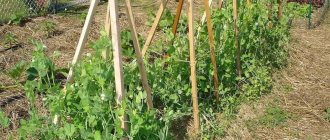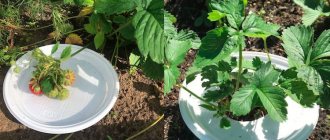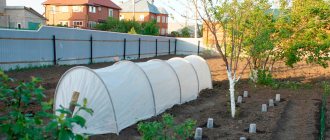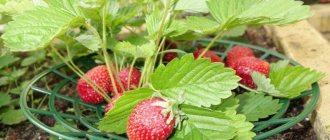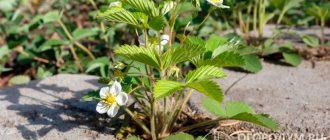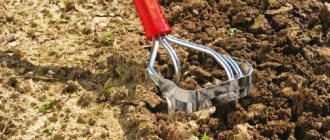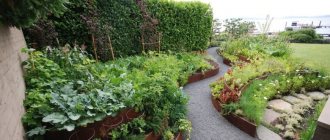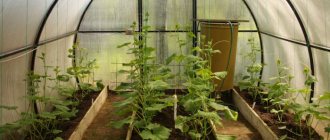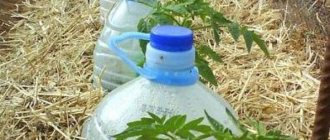Why do you need supports for currants?
Support is needed for proper formation of the bush. Thanks to the support, the plant takes up less space on the site, and it is easier for gardeners to harvest. The shrub is more well-groomed; the branches do not fall down or sag under the weight of ripe fruits.
It is also easier for summer residents to work with the soil: water, fertilize, loosen and mulch. In winter, covering material is fixed to the fences, which protects the bushes from gusty winds and frosts.
If currants grow without supports, the branches lie on the ground, and the fruits come into contact with the ground, which causes diseases. If the ground is wet, the berries become covered with plaque, mold or rot. When caring for shrubs, you have to lift the shoots yourself with one hand - this is inconvenient.
Advantages and disadvantages
The supports are functional: they are safe for the plant, simplify harvesting and maintenance, and promote ventilation of the root system. They are stable, lightweight, and easy to install. If the garden plot is decorated in a certain style, the supports serve as a decorative element.
Supports harm the plant only if the structure is tight and prevents the currants from developing. Also dangerous for currants are fences installed with technological violations, for example, weakly stable or with an excessive height.
How to make props with your own hands
Gardeners make supports for currants from wooden pegs, PVC pipes, branches or metal. To do this, prepare tools and take measurements.
From wooden pegs
Wood is a reliable, environmentally friendly and practical material; besides, in every household there are unnecessary boards.
The above-ground part of such a structure must be at least 50 cm. In order for the support to withstand winds, it is buried 40 cm. To make a support from wooden pegs, in addition to boards, you will need self-tapping screws, a screwdriver, and a hammer.
Manufacturing instructions:
- Make a mark of 70-80 cm on a board or beam.
- Cut 4 supports.
- Drive them around the currant bush in the shape of a square.
- Cut 4 thin boards from the timber.
- Attach them using self-tapping screws to the supports.
From the branches
Branch supports are the simplest design. To make it, you need a narrow strip, 4 branches 75 cm long, self-tapping screws, a screwdriver and a hammer. Gardeners drive branches around the perimeter of the bush, then secure the planks to them with self-tapping screws on pegs. This procedure takes no more than an hour. However, supports made from branches are short-lived and last no more than one season.
Attention! From branches you can make a structure on two legs. This support looks like a bracket and supports only one part of the berry bush.
Made from PVC pipes
PVC pipes are more expensive compared to wooden pegs and branches, but such structures last a long time and are functional. The pipes consist of two layers of polyvinyl chloride, between which an aluminum pipe is placed. The supports do not break in the wind and hold any covering material. The outer layer of PVC pipes is not afraid of rain and snow and is resistant to rotting.
To make a support, you need a fiberglass pipe 4 m long, a wire with a diameter of 5 mm, a hammer and a knife.
Manufacturing process:
- Cut the PVC pipe so that you get 4 supports 75 cm long.
- Make through holes in each.
- Place supports around the currants.
- Pass the wire through the holes.
- Use construction adhesive to secure parts.
Made of metal
Metal fencing is the most reliable and durable. They are not afraid of any weather conditions. The metal can support plants of any size and weight and is protected from corrosion.
The disadvantage is the complexity of manufacturing and heavy weight. To create the structure you will need a metal pipe and wire, as well as a hammer, grinder and pliers.
What to do:
- 4 supports 75 cm long are cut from the pipe.
- One through hole is made in each.
- Drive supports around the perimeter of the plant.
- Pull the metal wire through the holes and tighten firmly.
- To protect against moisture, the holes are plugged with plugs.
- Cover the support with protective paint - it will prevent corrosion.
From a metal rod
A metal rod is a thin rod. To make a support, it is bent in half around the tree to form an arc.
The rod is placed in the ground to a depth of 50 cm, and the rod should support the currant branches. The design is durable and easy to manufacture.
From lawn lamps
To create an original support, use non-working lawn lights. They are disassembled, the upper part of the lampshade is removed and installed around the perimeter of the bush. If the height of the lanterns is small, branches or wooden stakes are tied to them.
A cord or wire is attached to each support, on which currant branches are laid. The advantage of the support is that lawn lights, thanks to their sharp base, can be easily driven into the ground.
This is interesting:
How to grow purple roses and which varieties to choose
Why are black currants black?
Varieties and independent production of trellises for grapes
Quick fencing methods
To fence the best varieties of blackcurrant, you can use various elements from old and unnecessary household items. This is how an old bicycle rim without spokes can become the basis of a fence. To do this, several vertical supports are dug around the bush, to which the wheel rim is attached. An old chair without a seat or a broken stool is good for fencing berry bushes. Very often, old car tires become an element of garden design. They can be cut into several rings, which can be easily mounted on vertical supports. This article will tell you about Dutch varieties of tomatoes.
Selection and purchase of ready-made bush holders
When choosing a ready-made bush holder, pay attention to the shape, size, and color. For young and compact bushes, round supports with 2-3 legs are suitable, for mature and branched plants - square ones with 4 supports. Wooden supports are attractive due to their low price, but they only last 1-2 years. The shelf life of metal ones is about 5 years, because after that they undergo corrosion and lose their appearance and functionality.
Plastic supports have no such restrictions - they are lightweight, affordable, and durable.
For berry bushes, it is better to buy collapsible bush holders than monolithic ones. In the first case, it is easier to choose the size and shape for a specific bush. In addition, the plant is constantly changing - it is impossible to predict what it will be like in 2-3 years. When purchasing, make sure that there are no cracks or scratches on the supports.
Buy stands for bushes
Stands and fences for bushes are presented in a wide variety, and these practical products are in good demand.
Metal fencing for bushes
Made from powder coated steel. Can be of various colors and configurations. Forged metal fences look especially beautiful.
Welded metal fences are the strongest and have a number of advantages:
You can buy a bush holder made of steel from 350 rubles. Forged metal stands will cost much more.
Plastic stands for shrubs
Plastic fencing has a favorable price and a large selection depending on the purpose: “currant”, “cascade”, “peony”, “rose”, “pyramid” and others. Plastic fencing is easy to install and easy to disassemble and assemble.
The advantages of plastic bush holders are as follows:
The cost of plastic bush holders varies from 140 to 300 rubles.
When choosing a stand for shrubs, you should consider the following design features of the product:
How to strengthen currants with supports yourself
Proper currant garter protects the plant from diseases and pests and makes it easier to care for the bush throughout the growing season. Tied fruits are better illuminated by sunlight and grow larger and more appetizing.
Currants are tied up in the third year after planting. During this period, the height of the plant reaches 1.5 m, and the first harvest is formed on the shoots. There is no point in tying up the bush before.
Required materials and tools
Easy to use plastic clips or clothespins . They are sold at any gardening store and look similar to clothespins. They are inexpensive, take up little space, and are suitable for repeated use. However, they can only be used for attaching currants to thin supports.
For large and thick supports, special garter belts are used. They have fasteners. With their help, the belt can be easily tightened on structures of any diameter. These can be thin metal pipes or massive wooden stakes. Garden belts have been used for many years.
Possible schemes
In addition to tying a currant bush onto a single frame, gardeners use tying schemes for trellises, pipe supports, and a triangle:
- A series of metal or wooden stakes 80 cm high are driven in near the currants. A wire or rope is hooked between them, and currant branches are tied to it. Gartering on trellises is relevant for those who grow 5 or more bushes in one row on a plot.
- To tie currants to pipes, install 2, 3 or 4 pipes around the perimeter of the bush. This design is very similar to a single frame garter.
- An equilateral triangle is built around the currant from 3 stakes. The plant is tied to each side using clothespins or belts. The triangle is an original way of gartering; it looks unusual, especially if you use multi-colored stakes instead of plain ones.
Advice from experienced gardeners
In order to properly fence currants and buy the necessary stands, experienced gardeners recommend first of all paying attention to the material of manufacture . Be sure to take into account the size and age of the bush. If there are several plants, buy a special structure that makes it easy to tie up 2 or more bushes.
Install the support at a depth of 50 cm so that it is stable. If the fence is metal, check it regularly for corrosion; if it is wooden, check it for mold and traces of rot. If such signs are detected, the fences are replaced with new ones.
Mistakes to Avoid
A common mistake is using strips of natural or synthetic fabrics for support. They pull the shoots and break them, so it is better to use special clothespins or belts.
Also, newbie gardeners think that they need to tie up currants 1-2 times. But this is not so: the plant is constantly developing, which means it needs to be tied up regularly, as the shoots grow.
Attention! Do not pull the branches too tightly. This leads to the branches drying out and losing the entire harvest. It is impossible to restore such shoots.
Possible difficulties
The legs of any holder go into the soil and if the soil is loose (for example, with a lot of sand), the device will be unstable. In this case, additional support from the bush holder is required.
Trellis and other structures are usually made from lightweight materials. This makes them easier to install and operate, but can lead to instability in regions with frequent high winds. This must be taken into account when choosing the material for making the support. Advice for this case: plant currants near fences and other barriers. Then both the plant itself and its holder will be more resistant to winds.
Metal structures with many sharp parts can be hazardous and require care during installation. Not all types of currants are flexible enough to be mounted on a trellis.
Red and white are best. Winter-hardy and regional varieties take root well. It is recommended to use bush holders for species whose fruits ripen on long clusters
Not all types of currants are flexible enough to be mounted on a trellis. Red and white are best. Winter-hardy and regional varieties take root well. It is recommended to use bush holders for species whose fruits ripen on long clusters.
Plastic devices should not be left in the ground over the winter, otherwise they will quickly fail. They must be removed in the fall and returned to the site in the spring.
Have you already made or purchased currant fences on your site?
Not really
